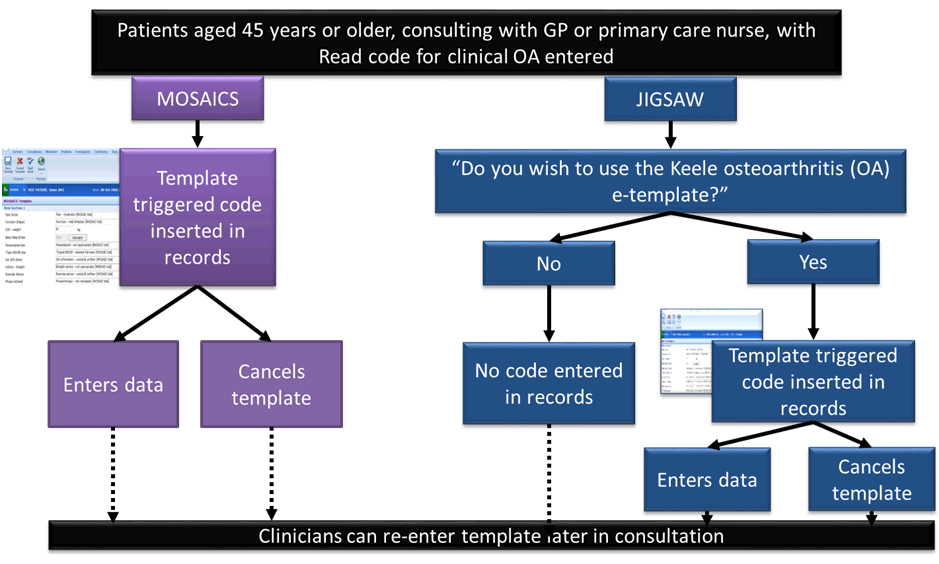Quality indicators of care
Two tools to support collection of data regarding quality indicators of care have been developed and implemented:
Background:
Within MOSAICS, an e-template was developed to aid recording of indicators of high-quality care that were historically poorly captured on within routine primary care medical records. At the time, the NICE Quality Standards for osteoarthritis had not been developed and a systematic review was undertaken to identify accepted indicators of high quality osteoarthritis care. However, the use of the e-template was subsequently identified to be a behaviour change intervention in its own right, for example, by prompting safer prescribing approaches, and was well aligned with the subsequent NICE Quality Standards.
Supporting evidence
Paper detailing identification of quality indicators of care: Edwards JJ, Khanna M, Jordan KP, Jordan JL, Bedson J, Dziedzic KS. Quality indicators for the primary care of osteoarthritis: a systematic review. Ann Rheum Dis. 2013;74(3):490-8.
Paper detailing the impact of use of the osteoarthritis e-template in primary care: Edwards JJ, Jordan KP, Peat G, Bedson J, Croft PR, Hay EM, Dziedzic KS. Quality of care for OA: the effect of a point-of-care consultation recording template. Rheumatology (Oxford). 2015;54(5)):844-53.
Use in JIGSAW-E
Within England the e-template has been rolled out as it were in MOSAICS, except that healthcare professionals are given the option of using it by a prompt (as opposed to it automatically firing) upon entering a Read code consistent with osteoarthritis (i.e. osteoarthritis diagnostic code or a joint pain code) (see Figure). However, due to issues relating to cultural acceptability and/or information technology infrastructure, the e-template has not been directly translated into the clinical systems in other countries. Therefore, the key functions of the e-template were distilled and where the e-template could not be implemented in the same way, alternative methods were acceptable if they fulfilled these key functions:
- PROMPT – healthcare professionals are prompted to consider evidence-based management approaches
- RECORD – high quality care can be recorded (ideally directly within patient records)
- RETRIEVE – recorded high quality care can be searched for and “retrieved”
- REPORT – aggregated data regarding high quality care can be produced

Patient reported quality indicators of care questionnaire
Background:
Within MOSAICS a patient report quality indicator questionnaire was developed to enable assessment of care patients perceived to have received.
Supporting evidence
Development of the patient report quality indicator questionnaire: Blackburn S, Higginbottom A, Taylor R, Bird J, Osteras N, Hagen KB, Edwards JJ, Jordan KP, Jinks C, Dziedzic K. Patient-reported quality indicators for osteoarthritis: a patient and public generated self-report measure for primary care. Research Involvement and Engagement. 2016;2:5.
Results from the patient report quality indicator questionnaire survey: Healey EL, Afolabi EK, Lewis M, Edwards JJ, Jordan KP, Finney A, Jinks C, Hay EM, Dziedzic KS. Uptake of the NICE osteoarthritis guidelines in primary care: a survey of older adults with joint pain. BMC Musculoskeletal Disorders. 2018;19:295.
Use in JIGSAW-E
To ensure that a patient-reported quality indicator questionnaire would be acceptable to patients receiving real-world care, the MOSAICS questionnaire was reviewed and refined, by the JIGSAW-E team and implementation patient and public LINK group. The resulting questionnaires can be downloaded using the links below:
